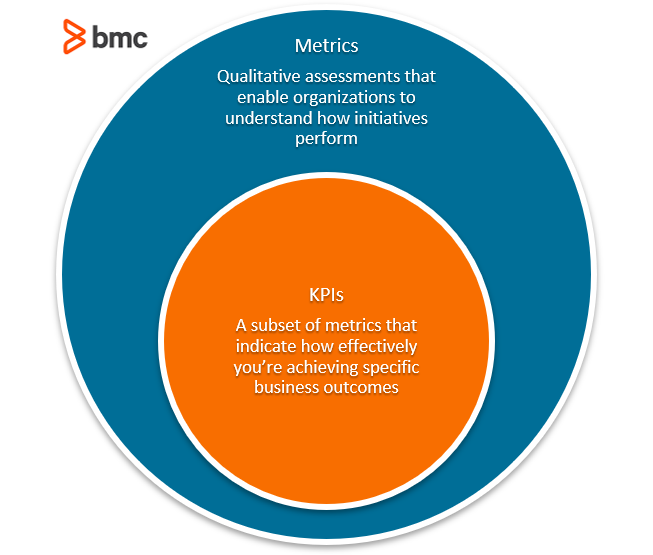IT metrics are quantitative assessments that enable organizations to understand the performance of their IT initiatives. Key Performance Indicators (KPIs) are a subset of metrics to illustrate how effectively specific business objectives associated with IT performance are achieved.

Let’s take a look at common IT metrics and KPIs and how to choose the best metrics for your organization.
What do IT metrics track?
Even when technology is not a core business of your organization, you can take advantage of vast volumes and variety of data to make well-informed strategic decisions. The strategic significance of IT metrics can be described in two domains:
- Technology Performance. Data generated by connected technologies, IT infrastructure, and technology systems can be gathered, processed, and analyzed to identify technology performance. This information can be used to maintain efficiency of technology systems at lower costs.
- Business Performance. This data also contains hidden insights on the impact of strategic choices on business performance. In order to drive the best business outcomes, IT must identify and analyze metrics that correlate highly with business performance.
Some important IT metrics and KPIs fall in the following domains and categories:
Operational Metrics
Operational KPIs help organizations track performance over a pre-defined period or in real time. These metrics are associated with a range of business functions. But, in the domain of enterprise IT, operational metrics focus primarily on the performance of IT resources and functions. These resources include the workforce, technologies and services used to conduct business operations or enable products and services to end-users. Examples of operational metrics include:
- HR: Workforce productivity, overtime hours, employee turnover rate, cost of hiring and training.
- IT Infrastructure: Infrastructure downtime, frequency of production deployments, number of workloads processed, capital and expense cost, resource availability.
- IT Solutions and Services: Service uptime, availability, reliability, cost per user, cost per user acquisition, network outages.
- ITSM and Service Desk: Service availability, First Call Resolution Rate, cost per contact, SLA breach rate, user satisfaction
Operational metrics overlap with a range of categories that focus on unique aspects of organizational operations driven by technology. These metrics evaluate how the resources made available to various functions of the organization contribute to the overall business performance.
System Reliability
IT systems, including hardware infrastructure and applications, must operate reliably—every second of downtime incurs revenue losses. The metrics associated with system reliability help organizations evaluate historical performance and predict future performance. These metrics not only empower IT teams to perform upgrades and maintenance activities proactively but also give the business confidence to scale operations and pursue new business opportunities that rely on stable and reliable IT systems performance.
These metrics are mostly focused on the technology performance and require additional layers of analytics and correlations to evaluate correlations with the business performance. Common examples of system reliability metrics include:
- Outages: Mean Time to Resolve (MTTR), Mean Time to Failure (MTTF), frequency and schedule of planned and unplanned outages, redundancy levels for power and utility supplies, hardware assets
- Network: Capacity, latency, incidents
- Procurement: hardware resources that are not easily replaced by strategic suppliers and standard channels of procurement
- Cost: Operational and capital expenses, cost per user, cost per unit asset such as data storage
- Security: Data breaches and network infringements encountered and deflected, security policy adherence, cybersecurity awareness training drills and results
IT Support and Customer Expectations
Measuring user satisfaction helps organizations identify operational and performance issues within their organization and its IT resources. The IT service desk for instance, is established to ensure that IT services are delivered effectively to internal and external end users. The performance of the IT service desk has a direct correlation with organizational capacity to deliver the expected services and satisfaction levels of end-users.
Some common examples for metrics that track IT support and customer experience include:
- Service Availability: How readily is the promised service made available to the end-user, as per expected performance, quality and dependability. Repeated outages, recurring technical and security issues compromise service availability and hence, customer expectations of the service quality
- Common IT Metrics:
- Mean Time to Resolve (MTTR) represents the average time taken to resolve a ticket.
- Mean Time Between Failure (MTBF) represents the time between failures.
- Mean Time to Failure (MTTF) represents the system uptime after a possible issue has been resolved.
- These metrics must be evaluated collectively: a dependable service fails less frequently, resolves fast after a failure and remains available for prolonged duration.
- Service Desk Metrics: First Call Resolution Rate, Cost per Contact, Customer Satisfaction, Net Promoter Score, Agent Satisfaction
Service Level Agreements (SLAs)
Most organizations procure a range of IT services and technology solutions. SLAs oblige vendors to deliver promised service levels defined by specific metrics. Failure to comply with these metrics not only penalizes vendors but also impacts end users and, therefore, revenue generating opportunities. It is therefore critical to identify the metrics that best describe the required performance levels. Examples of SLA metrics include:
- SLA Compliance Ratio: The ratio between number of incidents resolved in compliance with SLA and the total number of incidents
- SLA Performance: Uptime, Scale up/down capacity, response time, storage
- SLA Verification: Defect rates, technical quality, security, business results/KPIs, number of complaints
Financial Metrics
The performance of IT is a natural tradeoff with financial investments. It is therefore critical to evaluate the financial performance of an IT initiative. The optimal tradeoff between cost, performance, security and other ROIs should be considered with designing and evaluating IT metrics and KPIs. Some common financial metrics include:
- Cost: Cost of budget, budget variance, resource cost, maintenance and support expenses
- Scheduling: Scheduling variance and schedule overhead
- Risk: Legal, societal, and natural causes impacting business performance or ability to scale a product functionality and service to extended marketplaces
Digital transformation
Many organizations are actively or passively going through a digital transformation.
Recent research indicates that 76% of companies today are looking to increase IT spending, with a particular focus towards automation and emerging technologies. Harnessing these frees organizations to better capitalize on human intellect, skills, and creativity. This ideal state is known as an Autonomous Digital Enterprise (ADE).
So, how far along are you in this transformation?
Digital transformation metrics incorporate some of the metrics we’ve already covered in this article. Still, for any successful change, you need to benchmark what you’re measuring.
Choosing the right metrics for your business
Finding the right IT metrics strategy is not about deploying sophisticated analytics technologies. It’s about identifying the metrics that yield most insightful knowledge that can help align IT with desired business goals. Specifically, the chosen IT metrics and KPIs should help organizations find accurate and actionable answers to the following questions:
- How productive is the IT staff using the available technology resources?
- Are end-users and customers satisfied with the available services and support?
- How dependable is the performance of core products and technology solutions?
- Are the IT projects delivered efficiently and effectively?







